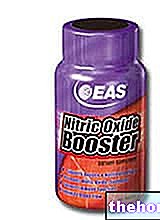Generality
Chromium is a micronutrient present in trace amounts in our body.
Its important role as a cofactor in enhancing insulin function has been known since 1959.

From these assumptions derives the business of supplements in which chromium is found in the form of chromium picolinate.
In fact, this salt represents an excellent compromise between bioavailability (effective absorption of chromium) and risk of toxic effects (typical, for example, of hexavalent chromium).
There is no recommended daily ration of Chromium for the Italian population.
In the Bel Paese, the levels of ingestion derived from the analyzes carried out on the national diet are equal to 20.6 µg / day and the foods that contribute most to the total ingestion of chromium are vegetables (59.3 µg / day), cereals and derivatives (48.2 µg / day), followed by fruit (33.2 µg / day) from meat, fish and eggs (14.7 µg / day) and from milk and derivatives (13.1 µg / day) (Gambelli L., 1994).
According to the LARN for the Italian population, the adequate intake of chromium would be:
Babies
7 to 12 months: 4 mcg
Children
from 1 to 3 years: 7mcg
from 4 to 8 years: 10 mcg
9 to 13 years: 14 mcg
Teenagers
males 14 to 18 years: 25 mcg
females 14 to 18 years: 33 mcg
Adult men
19 to 50 years: 35 mcg
+ 50: 30 mcg
Adult Women
19 to 50 years: 25 mcg
+ 50: 20 mcg
pregnant: 30 mcg
breastfeeding: 45 mcg
Where mcg = µg = micrograms
Indications
Why is chromium used? What is it for?
Classically, hypoglycemic properties are ascribed to Chromium.
These activities, although the molecular role is not yet fully understood, seem to be attributable to the ability of chromium to act on the insulin signal, enhancing it.
The activating action against the insulin receptor and the probable ability to improve hepatic glucose metabolism would further support the metabolic role of chromium.
By virtue of its biological potential, Chromium was used:
- As a hypoglycemic agent in dysmetabolisms;
- As an ergogenic support in sports;
- As a supplement able to assist in the improvement of body composition.
Properties and Effectiveness
What benefits has chromium shown during the studies?
Several studies have been published in the literature which show the biological potential of chromium.
Although there are clearly still many conflicting opinions, in some studies Chromium:
- It would appear to improve fasting glucose, basal insulin concentrations and glycosylated hemoglobin levels, as observed in approximately 180 patients with type 2 diabetes;
- It would favor an appreciable decrease in the concentrations of total cholesterol and LDL cholesterol;
- It would improve body composition, optimizing muscle growth and facilitating fat loss, measured instrumentally with DEXA, in athletes undergoing training.
However data not confirmed by subsequent works (Med Sci Sports Exerc 1998; 30: 1730-7),
On the other hand, no appreciable benefit would be recorded in the treatment of obesity, compared to a low-calorie diet rich in fiber.
Dosage and method of use
How to use Chromium
Estimated at about 25-35 mcg the adequate daily intake of chromium, supplementation generally uses doses between 20 and 200 mcg / day.
Amounts sometimes doubled in some studies.
The most popular chromium supplements on the market are chromium picolinate, although other forms of chromium are also present, such as chromium polynicotinate and chromium chloride.
Side effects
Chromium competes with iron for binding to transferrin, a protein that transports iron mobilized from deposits into the blood.
A chronic overdose of Chromium picolinate could therefore favor the establishment of anemic pictures.
Some studies have shown that picolinic acid contained in chromium picolinate can alter the parotid gland and negatively affect cell shape and function; cases of renal damage at high doses have also been reported (Ann Pharmacother 1998; 32: 428-31 )
Case reports have also denounced the onset of anemia, thrombocytopenia, liver failure and rhabdomyolysis in patients undergoing supplementation with high doses of chromium picolinate.
Contraindications
When should chromium not be used?
The use of chromium is contraindicated in case of hypersensitivity to the active principle.
Pharmacological interactions
Which drugs or foods can modify the effect of chromium?
The simultaneous use of ascorbate and foods containing ascorbate could increase the intestinal absorption of chromium.
On the contrary, the presence of phytates could compromise their absorption.
It should also be remembered that chromium could enhance the metabolic effects of hypoglycemic drugs.
Precautions for use
What do i need to know before taking chromium?
The intake of chromium, through supplements, should not exceed the maximum limits allowed, especially during pregnancy and in the subsequent period of breastfeeding.
The use of chromium should also be avoided in patients with hypoglycemia and supervised by the doctor in patients with diabetes or alterations in glucose metabolism.
















.jpg)











